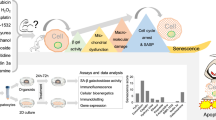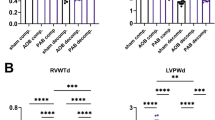Abstract
Hypoxia is a potent regulator of gene expression and cellular energy metabolism and known to interfere with post-natal growth and development. Although hypoxia can induce adaptive changes in the developing liver, the mechanisms underlying these changes are poorly understood. To elucidate some of the adaptive changes chronic hypoxia induces in the developing liver, we studied the expression of the genes of mammalian target of rapamycin (mTOR) signaling and glucose metabolism, undertook proteomic examination with 2D gel-MS/MS of electron transport chain, and determined activities and protein expression of several key regulatory enzymes of glucose oxidative metabolism. To gain insight into the molecular mechanism underlying hypoxia-induced liver metabolic adaptation, we treated a subset of mice with rapamycin (0.5 mg/kg/day) to inhibit mTOR postnatally. Rapamycin-treated mice showed lower birth weight, lower body weight, and liver growth retardation in a pattern similar to that observed in the hypoxic mice at P30. Rapamycin treatment led to differential impact on the cytoplasmic and mitochondrial pathways of glucose metabolism. Our results suggest a decrease in mTOR activity as part of the mechanisms underlying hypoxia-induced changes in the activities of glycolytic and TCA cycle enzymes in liver. Chronic postnatal hypoxia induces mTOR-dependent differential effects on liver glycolytic and TCA cycle enzymes and as such should be studied further as they have pathophysiological implications in hepatic diseases and conditions in which hypoxia plays a role.





Similar content being viewed by others
Abbreviations
- CS:
-
Citrate synthase
- HK:
-
Hexokinase
- KGDHC:
-
α-Ketoglutarate dehydrogenase complex
- LDH:
-
Lactate dehydrogenase
- mTOR:
-
Mammalian target of rapamycin
- PDH:
-
Pyruvate dehydrogenase
- PDK:
-
Pyruvate dehydrogenase kinase
- PK:
-
Pyruvate kinase
References
Iadecola C, Salkowski CA, Zhang F, Aber T, Nagayama M, Vogel SN, Ross ME (1999) The transcription factor interferon regulatory factor 1 is expressed after cerebral ischemia and contributes to ischemic brain injury. J Exp Med 189:719–727
Janssens JP, Pautex S, Hilleret H, Michel JP (2000) Respiratory sleep disorders in the elderly. Rev Med Suisse Romande 120:869–879
Mathur R, Cox IJ, Oatridge A, Shephard DT, Shaw RJ, Taylor-Robinson SD (1999) Cerebral bioenergetics in stable chronic obstructive pulmonary disease. Am J Respir Crit Care Med 160:1994–1999
Kuroiwa S, Katai N, Yoshimura N (1999) A possible role for p16INK4 in neuronal cell death after retinal ischemia-reperfusion injury. Invest Ophthalmol Vis Sci 40:528–533
Henrion J, Schapira M, Luwaert R, Colin L, Delannoy A, Heller FR (2003) Hypoxic hepatitis: clinical and hemodynamic study in 142 consecutive cases. Medicine 82:392–406
Ebert EC (2006) Hypoxic liver injury. Mayo Clin Proc 81:1232–1236
Kalaria RN, Fiedler C, Hunsaker JC III, Sparks DL (1993) Synaptic neurochemistry of human striatum during development: changes in sudden infant death syndrome. J Neurochem 60:2098–2105
Naeije R (2003) Hepatopulmonary syndrome and portopulmonary hypertension. Swiss Med Wkly 133:163–169
Seagroves TN, Ryan HE, Lu H, Wouters BG, Knapp M, Thibault P, Laderoute K, Johnson RS (2001) Transcription factor HIF-1 is a necessary mediator of the pasteur effect in mammalian cells. Mol Cell Biol 21:3436–3444
Schofield CJ, Ratcliffe PJ (2004) Oxygen sensing by HIF hydroxylases. Nat Rev Mol Cell Biol 5:343–354
Kim JW, Tchernyshyov I, Semenza GL, Dang CV (2006) HIF-1-mediated expression of pyruvate dehydrogenase kinase: a metabolic switch required for cellular adaptation to hypoxia. Cell Metab 3:177–185
Papandreou I, Cairns RA, Fontana L, Lim AL, Denko NC (2006) HIF-1 mediates adaptation to hypoxia by actively downregulating mitochondrial oxygen consumption. Cell Metab 3:187–197
Guillemin K, Krasnow MA (1997) The hypoxic response: huffing and HIFing. Cell 89:9–12
Chavez JC, Agani F, Pichiule P, LaManna JC (2000) Expression of hypoxia-inducible factor-1alpha in the brain of rats during chronic hypoxia. J Appl Physiol 89:1937–1942
Weinberg JM, Venkatachalam MA, Roeser NF, Nissim I (2000) Mitochondrial dysfunction during hypoxia/reoxygenation and its correction by anaerobic metabolism of citric acid cycle intermediates. Proc Natl Acad Sci USA 97:2826–2831
Semenza GL (2001) Hypoxia-inducible factor 1: control of oxygen homeostasis in health and disease. Pediatr Res 49:614–617
Holness MJ, Sugden MC (2003) Regulation of pyruvate dehydrogenase complex activity by reversible phosphorylation. Biochem Soc Trans 31:1143–1151
Roche TE, Baker JC, Yan X, Hiromasa Y, Gong X, Peng T, Dong J, Turkan A, Kasten SA (2001) Distinct regulatory properties of pyruvate dehydrogenase kinase and phosphatase isoforms. Prog Nucleic Acid Res Mol Biol 70:33–75
Heacock CS, Sutherland RM (1990) Enhanced synthesis of stress proteins caused by hypoxia and relation to altered cell growth and metabolism. Br J Cancer 62:217–225
Farahani R, Kanaan A, Gavrialov O, Brunnert S, Douglas RM, Morcillo P, Haddad GG (2008) Differential effects of chronic intermittent and chronic constant hypoxia on postnatal growth and development. Pediatr Pulmonol 43:20–28
Fan LW, Lin S, Pang Y, Lei M, Zhang F, Rhodes PG, Cai Z (2005) Hypoxia-ischemia induced neurological dysfunction and brain injury in the neonatal rat. Behav Brain Res 165:80–90
Kanaan A, Farahani R, Douglas RM, Lamanna JC, Haddad GG (2006) Effect of chronic continuous or intermittent hypoxia and reoxygenation on cerebral capillary density and myelination. Am J Physiol Regul Integr Comp Physiol 290:R1105–R1114
Bilali F, Kumar P, Feerick J, Berezin S, Farahani R (2008) Hypoxia-induced hypomyelination in the developing brain is mammalian target of rapamycin-4E-binding protein-1 signaling dependent. Neuroreport 19:635–639
Pettersen EO, Juul NO, Ronning OW (1986) Regulation of protein metabolism of human cells during and after acute hypoxia. Cancer Res 46:4346–4351
D’Angio CT, Finkelstein JN (2000) Oxygen regulation of gene expression: a study in opposites. Mol Genet Metab 71:371–380
Prabhakar NR (2001) Oxygen sensing during intermittent hypoxia: cellular and molecular mechanisms. J Appl Physiol 90:1986–1994
Webster KA (2003) Evolution of the coordinate regulation of glycolytic enzyme genes by hypoxia. J Exp Biol 206:2911–2922
Arsham AM, Howell JJ, Simon MC (2003) A novel hypoxia-inducible factor-independent hypoxic response regulating mammalian target of rapamycin and its targets. J Biol Chem 278:29655–29660
Hay N, Sonenberg N (2004) Upstream and downstream of mTOR. Genes Dev 18:1926–1945
Lawrence JC Jr, Abraham RT (1997) PHAS/4E-BPs as regulators of mRNA translation and cell proliferation. Trends Biochem Sci 22:345–349
Sipula IJ, Brown NF, Perdomo G (2006) Rapamycin-mediated inhibition of mammalian target of rapamycin in skeletal muscle cells reduces glucose utilization and increases fatty acid oxidation. Metabolism 55:1637–1644
Ramanathan A, Schreiber SL (2009) Direct control of mitochondrial function by mTOR. Proc Natl Acad Sci USA 106:22229–22232
Scafidi S, Douglas RM, Farahani R, Banasiak KJ, Haddad GG (2007) Prostaglandin transporter expression in mouse brain during development and in response to hypoxia. Neuroscience 146:1150–1157
Wu TL (2006) Two-dimensional difference gel electrophoresis. Methods Mol Biol 328:71–95
Clark JB, Lai JCK (1989) Glycolytic, tricarboxylic acid cycle and related enzymes in brain. In: Boulton AA, Baker BG, Butterworth RF (eds) NeuroMethods. Humana, Clifton, pp 233–281
Dukhande VV, Isaac AO, Chatterji T, Lai JC (2009) Reduced glutathione regenerating enzymes undergo developmental decline and sexual dimorphism in the rat cerebral cortex. Brain Res 1286:19–24
Gwak GY, Yoon JH, Kim KM, Lee HS, Chung JW, Gores GJ (2005) Hypoxia stimulates proliferation of human hepatoma cells through the induction of hexokinase II expression. J Hepatol 42:358–364
Semenza GL, Jiang BH, Leung SW, Passantino R, Concordet JP, Maire P, Giallongo A (1996) Hypoxia response elements in the aldolase A, enolase 1, and lactate dehydrogenase A gene promoters contain essential binding sites for hypoxia-inducible factor 1. J Biol Chem 271:32529–32537
Iyer NV, Kotch LE, Agani F, Leung SW, Laughner E, Wenger RH, Gassmann M, Gearhart JD, Lawler AM, Yu AY, Semenza GL (1998) Cellular and developmental control of O2 homeostasis by hypoxia-inducible factor 1 alpha. Genes Dev 12:149–162
Ebert BL, Firth JD, Ratcliffe PJ (1995) Hypoxia and mitochondrial inhibitors regulate expression of glucose transporter-1 via distinct Cis-acting sequences. J Biol Chem 270:29083–29089
Vannucci SJ, Reinhart R, Maher F, Bondy CA, Lee WH, Vannucci RC, Simpson IA (1998) Alterations in GLUT1 and GLUT3 glucose transporter gene expression following unilateral hypoxia-ischemia in the immature rat brain. Brain Res Dev Brain Res 107:255–264
Yecies JL, Manning BD (2011) mTOR links oncogenic signaling to tumor cell metabolism. J Mol Med 89:221–228
Wullschleger S, Loewith R, Hall MN (2006) TOR signaling in growth and metabolism. Cell 124:471–484
Coutant A, Rescan C, Gilot D, Loyer P, Guguen-Guillouzo C, Baffet G (2002) PI3K-FRAP/mTOR pathway is critical for hepatocyte proliferation whereas MEK/ERK supports both proliferation and survival. Hepatology 36:1079–1088
Lai JC, White BK, Buerstatte CR, Haddad GG, Novotny EJ Jr, Behar KL (2003) Chronic hypoxia in development selectively alters the activities of key enzymes of glucose oxidative metabolism in brain regions. Neurochem Res 28:933–940
Brugarolas J, Lei K, Hurley RL, Manning BD, Reiling JH, Hafen E, Witters LA, Ellisen LW, Kaelin WG Jr (2004) Regulation of mTOR function in response to hypoxia by REDD1 and the TSC1/TSC2 tumor suppressor complex. Genes Dev 18:2893–2904
Reiter AK, Bolster DR, Crozier SJ, Kimball SR, Jefferson LS (2005) Repression of protein synthesis and mTOR signaling in rat liver mediated by the AMPK activator aminoimidazole carboxamide ribonucleoside. Am J Physiol Endocrinol Metab 288:E980–E988
Tinton SA, Buc-Calderon PM (1999) Hypoxia increases the association of 4E-binding protein 1 with the initiation factor 4E in isolated rat hepatocytes. FEBS Lett 446:55–59
Acknowledgments
We thank Dr. Linda Mattiace and Melissa Kelly for technical assistance. This study was supported by grants from NIH/NINDS, the Gastroenterology Division, Pediatrics Department, Maria Fareri Children’s Hospital, New York Medical College and Idaho Biomedical Research Infrastructure Network (NIH NCRR BRINIP20RR016454).
Conflict of interest
None.
Author information
Authors and Affiliations
Corresponding author
Additional information
Vikas V. Dukhande and Girish C. Sharma contributed equally to this study.
Electronic supplementary material
Below is the link to the electronic supplementary material.
Rights and permissions
About this article
Cite this article
Dukhande, V.V., Sharma, G.C., Lai, J.C.K. et al. Chronic hypoxia-induced alterations of key enzymes of glucose oxidative metabolism in developing mouse liver are mTOR dependent. Mol Cell Biochem 357, 189–197 (2011). https://doi.org/10.1007/s11010-011-0889-z
Received:
Accepted:
Published:
Issue Date:
DOI: https://doi.org/10.1007/s11010-011-0889-z




